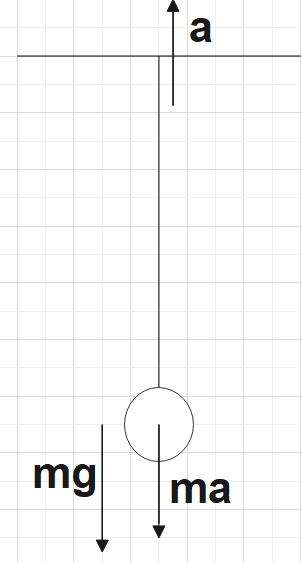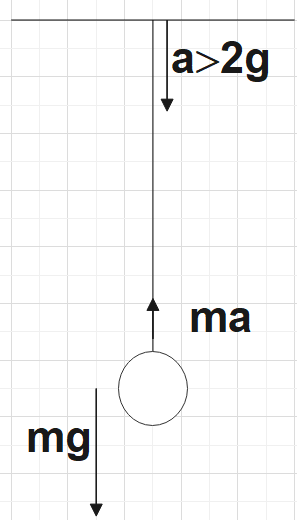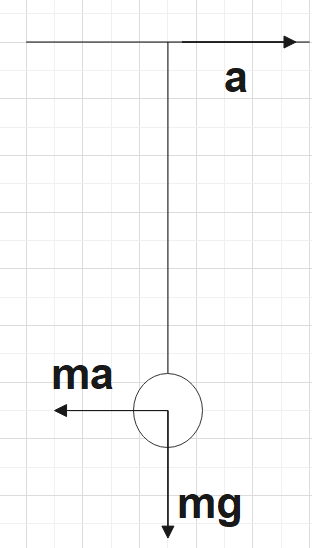
When the point of suspension of pendulum is moved, its period of oscillation
A. decreases when it moves vertically upwards with an acceleration a
B. decrease when it moves vertically upwards with an acceleration greater than 2g
C. increase when it moves horizontal with acceleration a
D. all of the above
Answer
505.5k+ views
Hint: One could read the question and then consider each of the given options one by one. You could make a free body diagram for each of the three cases and work accordingly. You could also make use of the expression for the time period of oscillation to make the conclusion in each case.
Formula used:
Time period of oscillation,
$T=2\pi \sqrt{\dfrac{l}{{{g}_{eff}}}}$
Complete step-by-step solution:
In the question, we are given a condition that the point of suspension of a simple pendulum is moved. We are supposed to find the change in the period of oscillation under this given condition.
Let us consider the first option,

Here since the point of suspension moves upwards, the pseudo force would be downwards. So, the net force would be given by,
${{F}_{net}}=m{{g}_{eff}}=mg+ma$
$\Rightarrow {{g}_{eff}}=a+g$
Now we have the time period of oscillation given by,
$T=2\pi \sqrt{\dfrac{l}{{{g}_{eff}}}}$
That is,
$T\propto \dfrac{1}{\sqrt{{{g}_{eff}}}}$……………………………….. (1)
Since ${{g}_{eff}}\rangle g$, we could say that the time period of oscillation decreases in this case. Hence, option A is true.
For the second option,

Here the net force could be given as,
${{F}_{net}}=m{{g}_{eff}}=ma-mg$
$\Rightarrow {{g}_{eff}}=a-g$
Since $a\rangle 2g$, which would further imply that ${{g}_{eff}}\rangle g$and from (1) we could conclude that the time period of oscillation would decrease here also. Hence, option B is true.
For the third case,

Here the net force would be,
${{F}_{net}}=m{{g}_{eff}}=\sqrt{{{\left( mg \right)}^{2}}+{{\left( ma \right)}^{2}}}$
$\Rightarrow {{g}_{eff}}=\sqrt{{{a}^{2}}+{{g}^{2}}}$
Clearly,${{g}_{eff}}\rangle g$, so here also the time period of oscillation would decrease. Hence option C is false.
Therefore, we found the options A and B to be true.
Note: One should always keep in mind that the direction of the pseudo force would always be in the direction opposite to the direction of the body’s acceleration. For the third case we have simply found the resultant force using vector addition. The key point for the whole solution is that time period decreases with increase in ${{g}_{eff}}$.
Formula used:
Time period of oscillation,
$T=2\pi \sqrt{\dfrac{l}{{{g}_{eff}}}}$
Complete step-by-step solution:
In the question, we are given a condition that the point of suspension of a simple pendulum is moved. We are supposed to find the change in the period of oscillation under this given condition.
Let us consider the first option,

Here since the point of suspension moves upwards, the pseudo force would be downwards. So, the net force would be given by,
${{F}_{net}}=m{{g}_{eff}}=mg+ma$
$\Rightarrow {{g}_{eff}}=a+g$
Now we have the time period of oscillation given by,
$T=2\pi \sqrt{\dfrac{l}{{{g}_{eff}}}}$
That is,
$T\propto \dfrac{1}{\sqrt{{{g}_{eff}}}}$……………………………….. (1)
Since ${{g}_{eff}}\rangle g$, we could say that the time period of oscillation decreases in this case. Hence, option A is true.
For the second option,

Here the net force could be given as,
${{F}_{net}}=m{{g}_{eff}}=ma-mg$
$\Rightarrow {{g}_{eff}}=a-g$
Since $a\rangle 2g$, which would further imply that ${{g}_{eff}}\rangle g$and from (1) we could conclude that the time period of oscillation would decrease here also. Hence, option B is true.
For the third case,

Here the net force would be,
${{F}_{net}}=m{{g}_{eff}}=\sqrt{{{\left( mg \right)}^{2}}+{{\left( ma \right)}^{2}}}$
$\Rightarrow {{g}_{eff}}=\sqrt{{{a}^{2}}+{{g}^{2}}}$
Clearly,${{g}_{eff}}\rangle g$, so here also the time period of oscillation would decrease. Hence option C is false.
Therefore, we found the options A and B to be true.
Note: One should always keep in mind that the direction of the pseudo force would always be in the direction opposite to the direction of the body’s acceleration. For the third case we have simply found the resultant force using vector addition. The key point for the whole solution is that time period decreases with increase in ${{g}_{eff}}$.
Recently Updated Pages
Master Class 11 Economics: Engaging Questions & Answers for Success

Master Class 11 English: Engaging Questions & Answers for Success

Master Class 11 Social Science: Engaging Questions & Answers for Success

Master Class 11 Biology: Engaging Questions & Answers for Success

Class 11 Question and Answer - Your Ultimate Solutions Guide

Master Class 11 Business Studies: Engaging Questions & Answers for Success

Trending doubts
What is meant by exothermic and endothermic reactions class 11 chemistry CBSE

10 examples of friction in our daily life

One Metric ton is equal to kg A 10000 B 1000 C 100 class 11 physics CBSE

Difference Between Prokaryotic Cells and Eukaryotic Cells

What are Quantum numbers Explain the quantum number class 11 chemistry CBSE

1 Quintal is equal to a 110 kg b 10 kg c 100kg d 1000 class 11 physics CBSE




